
Christopher and His Family Find Access To Valuable Support Services

When Christopher initially came to Easterseals Southern California (ESSC), Community Support Coordinator Mayra R. of Coordinated Life Services, a Living Options service line, was able to help identify gaps in his previous service – he was not attending an appropriate day program, he needed better quality personal assistant services, and he needed a functional wheelchair because his wheelchair did not fit him correctly.
Mayra provided support by accessing valuable resources and coordinating the services provided by multiple agencies that became involved in Christopher's life. They also helped Christopher and his family identify a day program in Whittier, which he now greatly enjoys attending. His mother, Cecilia, works full-time and it has greatly eased her mind to know that he is in good hands. She said that the program has made Christopher feel part of a community and she sees a positive difference in her son every day he attends the program.
"To be able to help Christopher's mother grow as an advocate and help her realize that it's ok to ask for help even though she's the parent was incredibly gratifying," Mayra said. "She was doing all of it on her own, paying everything out-of-pocket rather than through his insurance, not knowing she could get assistance. I showed her the ropes and let her know that this is something their insurance could help with."
Learn more about our Living Options Services here.
Our blog
-
Connecting and Thriving: Inside Easterseals Adult Day Services Virtual Community
Thursday, April 24, 2025, 5:23 PMConnecting and Thriving: Inside Easterseals Adult Day Services Virtual Community
Thursday, April 24, 2025, 5:23 PM
The Virtual Community has become an exciting project within Easterseals Southern California, and Sab…
Read this PostIt all started with a giant spreadsheet in Microsoft Excel.
“This was during the pandemic,” says Sabrina Pascual, now Director of the Virtual Community for Easterseals Southern California. “Since people couldn’t come to our sites, our various Adult Day Services (ADS) locations started planning their own online programming.”
For example, the ADS site in Van Nuys would host a webinar about cooking, while the West Covina site created a one-hour online event about painting.
Sabrina set up a spreadsheet to share this information throughout the organization. She listed all the remote activities, provided links, and emailed the file to the ADS sites every week. That way, people at various locations could join each other’s programs.
The spreadsheet kept growing and was becoming unwieldy, so Sabrina and her colleagues decided to move everything to an online platform. They didn’t realize it at the time, but that’s when the Virtual Community was born.

A Quick Fix Becomes a Permanent Resource
In the beginning, the website was simply a way to organize and promote all the different online activities happening across Easterseals ADS sites.
But as people began returning to on-site programming, it was clear that the virtual community remained valuable. Many had formed friendships through the site, people enjoyed the variety of offerings, and if participants were sick or couldn’t attend in-person for other reasons, it was an easy way for them to stay engaged.
In response, Sabrina and her team started building something more permanent:
- They created an Advisory Committee that included participants, to help organize and plan the weekly schedule of events.
- They added more resources to the site.
- They hired virtual coaches to help lead some activities—and other activities are taught by participants themselves.
They also made sure to prioritize accessibility. For example, the site:
- Does not require email addresses to log in. Instead, it uses a system of access codes.
- Uses alt text for images (text explanations of a visual, for the visually impaired).
- Uses navigation arrows throughout the site to reduce the need for scrolling.
- Is fully translatable into many languages, and they continue to add more languages.
Now, five years after the pandemic, the site is a robust and dynamic destination for around 300 people every month. What began as a social-distancing quick-fix has transformed into a thriving online community.
From Gaming Advice to Animal Facts
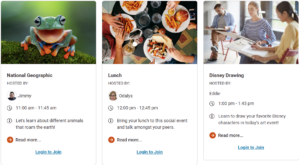
During the week, the Virtual Community hosts two events almost every hour, for a total of approximately 60 events per week. It covers a wide range of topics that are driven by participants’ interests, including:
- Music Enjoyment
- Pictionary
- Mysteries of the Ocean
- Karaoke
- Video Game Nostalgia
- Magician Secrets Revealed
- Theme Parks Around the World
- And so much more
There is also an Open Discussion Room from 10:00 a.m. to 1:00 p.m. every weekday, where people can just drop in to chat, share information they’ve learned from other Virtual Community activities, talk about current events, and more.
Benefits Beyond the Content

The events are engaging and popular, but they’re not the only benefit.
Through the Virtual Community, participants have learned more about how to use tech devices and navigate online spaces. It’s become a way to bridge the technology knowledge gap in the disability community.
People have also gained new skills and confidence as they lead activities or discussions.
And then there are the relationships. Since the beginning, the Virtual Community has helped foster connections across different locations, enhancing everyone’s sense of unity and belonging. This was evident during the January wildfires in Southern California, when some in-person services were suspended for safety, but people could still meet online and stay engaged and connected.
What’s Next
The Virtual Community has become an exciting project within Easterseals Southern California, and Sabrina and her team continue to find ways to make it a vibrant space for participants.
Going forward, the team is exploring ways to extend the community beyond Easterseals to California Regional Centers so that people outside the organization can join in. Expanding this unique resource could be invaluable to individuals and programs throughout California, creating access to services and true community for the people who need it most.
“The Virtual Community is transforming the way people in Adult Day Services connect and learn,” says Sabrina. “It’s something we couldn’t have imagined in the beginning. But throughout this journey, we’ve let participant input guide us. Now we have a fun and lively space with so much interesting content—and it keeps getting better.”
To learn more about the Virtual Community and how you can get involved, visit our website. You can also check out the Virtual Community here.
The post Connecting and Thriving: Inside Easterseals Adult Day Services Virtual Community appeared first on Easterseals Southern California Blog.
-
Disability in Pop Culture: Authentic Disability Representation in Film
Tuesday, April 15, 2025, 12:28 PMDisability in Pop Culture: Authentic Disability Representation in Film
Tuesday, April 15, 2025, 12:28 PM
In our latest Disability in Pop Culture blog series, we're highlighting productions that exemplify p…
Read this PostHollywood’s journey toward portraying authentic disability representation has faced challenges, from miscasting to harmful stereotypes. However, a growing number of films are prioritizing lived experiences, casting disabled actors, and crafting narratives that celebrate diversity without reducing characters to clichés. Below, we highlight productions that exemplify progress, offering nuanced portrayals that resonate with audiences and set new standards for disability in media.
A Quiet Place (2018)
A post-apocalyptic thriller directed by John Krasinski; A Quiet Place follows a family surviving in silence to evade deadly creatures that hunt by sound.
Featuring deaf actress Millicent Simmonds as Regan Abbott, this thriller integrates her deafness into the story in a meaningful way. The use of American Sign Language (ASL) and Simmonds’ lived experience brings authenticity to the film’s portrayal of deaf culture.
CODA (2021)
This Oscar-winning film follows Ruby Rossi, a teenager navigating life as the only hearing member of her deaf family in Gloucester, Massachusetts.
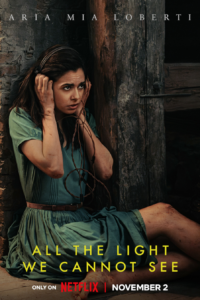
Starring deaf actors Marlee Matlin, Troy Kotsur, and Daniel Durant, CODA breaks barriers by centering deaf experiences both on-screen and behind the scenes. The film made history by becoming the first film with a predominantly deaf cast to win Academy Award for Best Picture. Followed by its success, it set a precedent for future productions to prioritize casting actors with disabilities.
All the Light We Cannot See (2024)
Netflix’s adaptation of Anthony Doerr’s Pulitzer Prize-winning novel follows Marie-Laure LeBlanc, a blind girl navigating life during World War II.
Starring blind actress Aria Mia Loberti as Marie-Laure LeBlanc, this series marks a significant step forward in authentic representation. Loberti’s disability enriches the narrative about resilience during wartime while offering a raw perspective on blindness.
Out of My Mind (2024)

A Disney+ adaptation of Sharon Draper’s bestselling novel, Out of My Mind, tells the story of Melody Brooks, a non-verbal wheelchair user with cerebral palsy who defies expectations.
This film stars Phoebe-Rae Taylor, an actress with cerebral palsy, as Melody Brooks. Taylor’s casting ensures authentic representation while the film thoughtfully explores challenges faced by individuals with CP in educational and social settings.
Bob Trevino Likes It (2024)
Bob Trevino Likes It is an indie drama that follows a young woman who forms an unexpected online friendship with a stranger named Bob Trevino.
The film offers a nuanced portrayal of disability through the character Daphne, played by Lauren ‘Lolo’ Spencer, who has a chronic condition. It highlights the importance of disability representation by casting an actress with a disability in a meaningful role.
Why Authentic Representation Matters
Authentic disability representation goes beyond casting; it requires thoughtful storytelling that reflects the complexities of living with a disability. These productions demonstrate how disability inclusion can elevate narratives while empowering disabled communities.
By prioritizing authentic casting and consulting creatives with disabilities, Hollywood has the opportunity to break down barriers—one story at a time.
What shows or movies have you seen that feature authentic disability representation? Share your thoughts in the comments below and stay tuned for more from Easterseals Southern California’s “Disability in Pop Culture” blog series!
The post Disability in Pop Culture: Authentic Disability Representation in Film appeared first on Easterseals Southern California Blog.
-
Easterseals March 2025 Recap: A Snapshot of Key Happenings
Tuesday, March 25, 2025, 3:05 PM
March was a vibrant month for Easterseals Southern California, marked by community engagement, educa…
Read this PostMarch was an eventful month for Easterseals Southern California, filled with community engagement, educational events, and inspiring moments. Here’s a look back at some of the key highlights that made this month special.
Read Across America Day with the Ontario Police Department
Easterseals Valley View Infant Center in Ontario was thrilled to invite the Ontario Police Department to celebrate Read Across America Day in early March! Officers joined the fun by reading books to our little ones, making this special day even more memorable. Thank you to our local police department for helping us foster a love of reading.
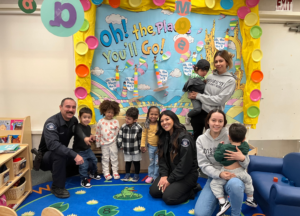
Abilities Expo 2025
Easterseals Southern California hosted a booth at the 2025 Abilities Expo from March 7-9, where we shared our mission, programs, and swag with hundreds of attendees. Our booth featured fun games, prizes, information about our services, and free “Disability is Not a Dirty Word” shirts for patrons. This annual event featured a wheelchair dance performance by the Rollettes, adaptive sports, informative workshops, group exercise, and vendors showing off the latest in disability technology and services.
San Diego Padres’ Preview Day
Easterseals Autism Services was invited to participate in the San Diego Padres’ annual “Preview Day,” which was a behind-the-scenes look at Petco Park’s sensory-friendly features. Families and staff from Easterseals Autism Services program in San Diego got a private tour of the stadium to experience the ballpark without the sensory overload of crowds. Features available to families include quiet spaces, a Sensory Activation Vehicle, sensory kits, and support from Guest Services. Watch the video below to learn more!
CalABA Conference 2025
Easterseals was honored to sponsor and attend CalABA’s 44th annual Western Regional Conference on Behavior Analysis, where thought leaders in Behavior Analysis gathered to share innovative strategies and insights. A special thanks to the Easterseals presenters, who represented Easterseals across multiple sessions, each discussing unique topics. We also want to thank the Advisory Board members for leading engaging sessions on data collection methods and enhancing service delivery through diverse perspectives. Together, we’re turning inspiration into action and shaping the future of Behavior Analysis!
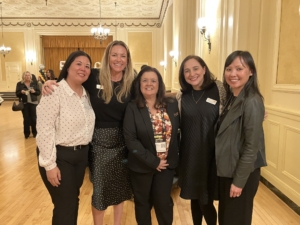
Thank You, Albertsons, Vons, and Pavilions Foundation
Easterseals participants had a chance to thank the Vons, Albertsons, and Pavilions Foundation for supporting disability services during Developmental Disabilities Awareness Month! Throughout March, customers could make in-store donations at check-out to create a big impact. A special shoutout to the participants and staff from Easterseals Adult Day Services Pyott Center who created a heartfelt poster to say thank you to their local Albertsons, where they shop weekly, along with Vons and Pavilions.

Stay In the Know
Learn more about what we’re doing at Easterseals on our website, and be sure to follow us on social media to stay up-to-date on the latest happenings across our service lines:
- Facebook: @EastersealsSoCal
- Instagram: @EastersealsSoCal
- TikTok: @EastersealsSoCal
- Bluesky: @eastersealssocal.bsky.social
- YouTube: @EastersealsSouthernCalifornia
The post Easterseals March 2025 Recap: A Snapshot of Key Happenings appeared first on Easterseals Southern California Blog.
-
The Power of Early Diagnosis: How Timely Autism Detection Can Change Lives
Monday, March 24, 2025, 12:55 PMThe Power of Early Diagnosis: How Timely Autism Detection Can Change Lives
Monday, March 24, 2025, 12:55 PM
Early intervention in autism can make a life-changing difference, but many families face delays in d…
Read this PostEarly intervention in autism can make a life-changing difference, but many families face delays in diagnosis and miss critical opportunities for support. Here at Easterseals Southern California, we talked to Crystal Leonard, Assessor, Applied Behavior Analysis, about the importance of early detection, key signs to watch for, and what to do about disparities in access.
Q: How prevalent is autism in America?
A: Approximately 1 in 36* children are diagnosed with autism spectrum disorder (ASD) in America. The numbers have been rising over the past few decades possibly due to increased awareness, broader diagnostic criteria, and improved screening methods.
Q: Why is early detection of autism important?
A: There are critical developmental windows when the brain has more neuroplasticity. If we can intervene in early childhood, we can see significant improvements in communication, social skills, and adaptive behaviors—and that can improve the child’s development and overall quality of life.
Q: When should a child be assessed for autism?
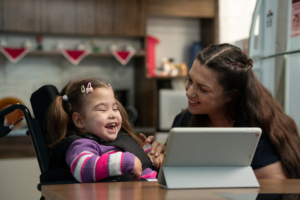
A: Young children can be reliably diagnosed with ASD as early as 18 months. Ideally, they will receive developmental screening tests at their 9-month, 18-month, and 24-month or 30-month well-child visits. If there are signs of developmental delays or atypical behaviors, a healthcare provider can conduct a more in-depth evaluation.
If you have any questions or concerns about your child’s development, please contact your pediatrician or, if you’re in California, you can also contact a local regional center.
Q: What are some signs of autism?
A: The signs can vary, but we often see:
- Delayed speech or language skills
- Limited eye contact
- Lack of interest in peer relationships
- Repetitive behaviors, like hand-flapping or lining up toys
- Intense focus on specific interests
- Sensitivity to sensory inputs like sounds or textures
Again, these signs can vary widely among children.
Q: If signs of autism are present, what is a parent’s first step?
A: Parents can consult their pediatrician or a child development specialist. The healthcare provider can conduct an initial screening and, if necessary, refer the child for a comprehensive evaluation by specialists. In California, a local regional center can be another good starting point.
Q: What are examples of how early intervention can make a difference in a child’s life?
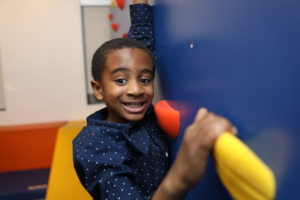
A: Early intervention makes a difference and has been associated with significant improvements. For example, children who received early interventions like Applied Behavior Analysis (ABA) therapy and speech therapy have shown notable gains in language development, adaptive behaviors, and skill development compared to those who started interventions later.
Q: How does early intervention help foster autism acceptance?
A: Early intervention not only supports the child’s development, it also educates families and communities about autism. This increased awareness creates a more inclusive and accepting environment, which reduces stigma associated with autism.
Q: What about people who are diagnosed later in life? Can they still benefit from autism services?
A: Yes. Many people are diagnosed with autism later in life, and for these individuals, receiving a diagnosis can be a turning point. It can help them better understand themselves, connect with others in the autism community, and access resources that can improve their quality of life.
Services for older individuals can include finding the right workplace accommodations, developing social connections, or accessing mental health resources. Autism services are valuable no matter when someone is diagnosed.
Q: Historically, minority communities and those from a lower socioeconomic status are less likely to receive the same amount and quality of healthcare services as others. Why is that?
A: Yes, these communities are less likely to see the same amount of services as other communities. They also report lower quality of care.
The barriers may include:
- The stress of the diagnostic process.
- Lack of caregiver knowledge. This includes knowledge about autism, developmental milestones, and the medical system.
- Not having the ability to advocate for one’s child to receive a diagnosis.
- Limited access to healthcare.
- Prejudices and beliefs of the clinicians.
- The family’s interpretation of the child’s symptoms.
- Cultural beliefs.
- Stigma on mental health issues and not seeking treatment.
Q: What kind of impact is this having on the outcomes of children with autism?
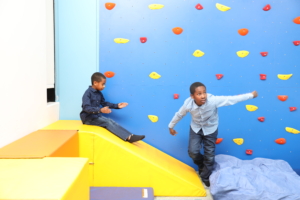
A: Without early intervention, children may miss critical windows for developing essential skills, causing further delays. They also face more pronounced challenges in communication, social interactions, and behavior. In other words, a higher severity of symptoms.
All of this can lead to higher levels of family stress and challenges for the child later in life.
Q: What kind of change needs to happen for these families to access autism services?
A: There are several changes that can help address this need, including:
- Community Outreach: Targeted programs can raise awareness about autism and available services in these communities.
- Cultural Competency Training: We need to educate healthcare providers to understand and respect cultural differences.
- Policy Reforms: We need policies that address systemic barriers, such as reducing financial obstacles and making services more available in underserved areas.
- Building the Workforce: We also need to encourage people from many different backgrounds to enter healthcare and educational fields. This will foster trust and relatability between providers and families.
Q: What is Easterseals Southern California doing in this area?
A: Our organization is taking several steps to help address these issues.
- We provide direct services through diagnostic clinics. These clinics provide opportunities to access free or low-cost diagnostic assessments for low-income, minority families.
- We educate communities by providing training on how to honor neurodiversity, implement new practices, and show support to people with autism.
- We reach out to connect families to necessary services. We have a network of health and social care providers—for example, housing, financial, legal assistance, and more that helps families access necessary resources.
- Internally, we provide staff trainings, input on recruitment practices, and a mentorship program to increase cultural responsiveness of our clinicians.
- We also create affinity groups to provide spaces for people who have a shared interest or experience, so they can support and empower each other and develop resources for the community.
The barriers can feel daunting, but these actions make a difference—and we are seeing healthcare workers, policy makers and communities come together. We share a common goal: to help children thrive.
Q: What is a good resource for parents who want to learn more about their child’s development?

A: Easterseals offers parents and caregivers free access to the confidential online Ages & Stages Questionnaires®, Third Edition
 (ASQ-3). The ASQ-3 is a set of questionnaires that helps you track your child’s development from one month through age 5. This screening provides a quick look at how children are doing in important areas, such as communication, physical ability, social skills, and problem-solving skills.
(ASQ-3). The ASQ-3 is a set of questionnaires that helps you track your child’s development from one month through age 5. This screening provides a quick look at how children are doing in important areas, such as communication, physical ability, social skills, and problem-solving skills.To learn more about Easterseals Southern California’s Autism Services and how we support people with autism through ABA Therapy, Occupational Therapy, Physical Therapy, and Speech and Language Therapy, visit our website. Easterseals also offers Enhanced Care Management and Severe Behavioral Services.
*More information from the Centers for Disease Control and Prevention
The post The Power of Early Diagnosis: How Timely Autism Detection Can Change Lives appeared first on Easterseals Southern California Blog.
-
Celebrating Marissa Bode, PR Week’s Communicator of the Year
Friday, March 14, 2025, 12:56 PM
In recognition of her powerful voice for change, Easterseals Southern California is honored to have …
Read this PostMarissa Bode, who stars as Nessarose in the hit movie “Wicked,” is breaking new ground for authentic disability representation across the entertainment industry. As a disabled actress, Bode’s vibrant, history-making portrayal of Nessarose has been the centerpiece of her growing platform to advocate and educate about disability.
In recognition of her powerful voice for change, Easterseals Southern California is honored to have partnered with PR Week to award Bode with a most prestigious honor: the 2025 Communicator of the Year.

A group of people smiling at a round dining table during a formal event, with plates, glasses, and smartphones visible on the table.
Presenting this award to Bode was truly exciting, as her work aligns with our ongoing efforts to shift the narrative about disability in the media. Recently, Bode participated in our collaboration with Variety, a leading entertainment industry outlet, as part of our multimedia report, Reimagining Hollywood: A New Lens on Disability Inclusion. You won’t want to miss the video with Bode alongside a group of powerhouse panelists chatting about how creatives with disabilities are building careers and changing the game industry-wide.
“Nobody knows us better than us,” Bode said during the panel, underscoring the fact that people with disabilities should be hired at every level of media production to ensure accurate representation and accessibility on set. She later added a reminder that disability is only one part of a person’s story: “Although I think our identities are of course important to our stories, that’s not all that we are. We’re so much more complex than…the boxes that we’re sometimes put into.”
Bode’s talents and the important insights she shares are indeed helping to bring the disability community outside of these narrow, limiting boxes. Members of the Easterseals team had the opportunity to celebrate Bode’s wise words and many accomplishments at the PR Week Awards event in New York City on March 13—a truly beautiful evening that shined a spotlight on the impact of the communications field.
We extend our heartfelt congratulations to Bode, and are so proud to support her journey as she continues to build momentum to create a more welcoming world for all.
The post Celebrating Marissa Bode, PR Week’s Communicator of the Year appeared first on Easterseals Southern California Blog.
Let's Keep in Touch
Don't miss out on exciting news, helpful resources, and impactful stories delivered to your inbox each month.
Join Today